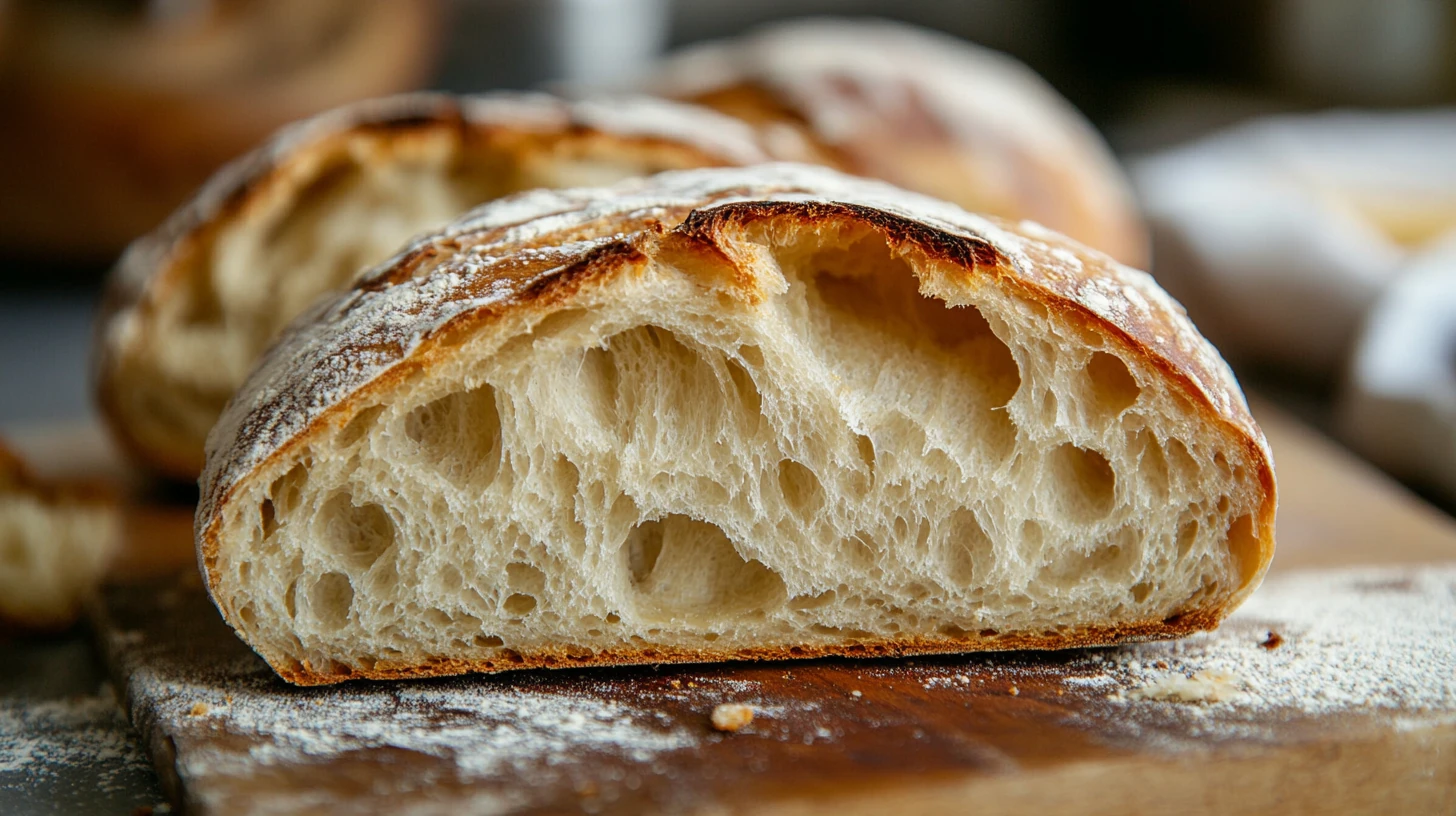Want to bake amazing sourdough but don’t have a Dutch oven? No problem! Learning how to bake sourdough without a Dutch oven is easier than you think. While a Dutch oven traps steam for a crisp crust, you can achieve the same results using simple alternatives. In this guide, you’ll discover five easy methods to get that perfect crust, plus pro tips to level up your sourdough—no fancy equipment needed.
Table of contents
Why does sourdough love a Dutch oven?
A Dutch oven is one of the best tools for baking sourdough because it creates the perfect environment for a crisp, golden crust and a beautifully risen loaf. It does this by trapping steam and maintaining high, even heat—two key factors that transform dough into artisan-quality bread.
During the first stage of baking, steam is crucial. It keeps the surface of the dough moist and flexible, allowing it to expand fully before the crust hardens. This leads to better oven spring, an airy crumb, and a thinner, crackly crust. Without enough steam, the crust sets too quickly, limiting rise and resulting in a denser loaf. The Dutch oven naturally traps steam released from the dough, creating a humid microclimate that mimics professional bread ovens.
Heat retention is the other major advantage. A preheated Dutch oven stores and radiates heat evenly, ensuring the loaf bakes consistently from all sides. The intense heat helps develop deep caramelization, giving sourdough its signature color and complex flavor. By enclosing the loaf in a heavy, heat-retaining vessel, a Dutch oven eliminates temperature fluctuations that can affect baking in a standard home oven.
While a Dutch oven is an effective tool, it’s not the only way to achieve great results. Learning how to bake sourdough without a Dutch oven is all about recreating its steam and heat conditions using simple kitchen tools. Let’s explore five effective alternatives.
Top 5 alternatives to a Dutch oven
You don’t need a Dutch oven to bake great sourdough. Here are five simple alternatives that help trap steam and maintain heat for a crisp crust and a light, airy crumb.
Baking stone or steel with an inverted pan
A pizza stone or baking steel absorbs and radiates heat, mimicking a professional oven floor. To trap steam, place a large metal bowl or an inverted roasting pan over the dough for the first half of baking.
A deep baking dish with a lid
An oven-safe pot, casserole dish, or even a stockpot with a tight-fitting lid works similarly to a Dutch oven by trapping steam around the bread. Preheat it with the oven for the best results.
A preheated baking sheet and an upside-down foil tray
Place the dough on a hot baking sheet, then cover it with an aluminum foil roasting pan or deep foil tray. This creates a mini steam chamber that helps the bread rise before the crust sets.
A large oven-safe mixing bowl and a baking sheet
Bake the bread directly on a hot baking sheet and cover it with a stainless steel or glass mixing bowl for the first 15–20 minutes. This traps steam effectively, similar to a Dutch oven.
A DIY steam setup with a water pan
Place a cast iron or metal pan on the bottom oven rack and add boiling water right before baking. The steam creates humidity, keeping the crust soft while the bread expands. For best results, use this method alongside a baking stone or steel to provide even heat distribution.
Pro oh là là tips for next-level sourdough
Once you’ve mastered the basics, these expert tips will take your sourdough without a Dutch oven to the next level—giving you better oven spring, a crispier crust, and deeper flavor.
- Supercharge your oven spring with extra steam: For maximum rise, try layering steam methods: use a covered setup (like an inverted pan) and place a preheated metal pan on the bottom rack with boiling water. The extra steam keeps the crust flexible for longer, leading to a taller, more open crumb.
- Preheat longer for bakery-quality heat: Most home ovens fluctuate in temperature, so don’t rely on the preheat beep. Let your oven heat for at least 45 minutes to an hour, especially if using a baking stone or steel. This ensures a steady, powerful heat source that mimics a professional oven floor.
- Bake with retained heat for an ultra-crispy crust: For an extra crispy crust, turn off the oven and leave the bread inside for 5–10 minutes with the door slightly open. This allows residual heat to drive out excess moisture without overbaking the crumb.
- Chill your dough for better flavor and structure: A long, slow cold-proof in the fridge (12–24 hours) enhances sourdough’s tangy flavor and makes the dough easier to handle. It also strengthens the gluten structure, leading to a more open crumb.
- Experiment with double baking for a shatteringly crisp crust: After the loaf has cooled completely, put it back in a 350°F (175°C) oven for 10 minutes. This technique removes any lingering moisture in the crust, making it extra crisp and giving it a deep, caramelized finish.
Common mistakes to avoid
Baking sourdough without a Dutch oven works beautifully—if you avoid these common mistakes.
- Skipping a proper preheat: A lukewarm oven leads to poor oven spring and a dense loaf. Always preheat for at least 45 minutes, especially if using a baking stone or steel, to ensure maximum heat retention.
- Not creating enough steam: Without steam, the crust sets too early, preventing the bread from expanding properly. Whether you’re covering the loaf or using a steam pan, make sure there’s enough moisture in the first 10–15 minutes of baking.
- Using too much flour on the dough surface: A light dusting helps with handling, but too much flour prevents steam from interacting with the crust, leading to a dull, floury finish instead of a crisp, caramelized exterior.
- Removing the cover too late or too early: Leaving a cover on for too long traps too much moisture, resulting in a thick, chewy crust. Removing it too soon causes the crust to dry out too early. The sweet spot is after 20 minutes of baking.
- Slicing too soon: It’s tempting to cut into fresh bread, but slicing too early releases steam trapped inside, making the crumb gummy. Wait at least one hour before cutting to allow the interior to fully set.
Frequently asked questions
How long to bake sourdough bread without a Dutch oven?
Baking time varies by method but generally takes 35–45 minutes at 450°F (230°C). Bread on a stone, steel, or sheet pan may bake faster since there’s no enclosed steam. If covering the loaf, remove the lid after 20 minutes to allow browning. Tap the bottom—if it sounds hollow, it’s done.
What happens if I bake sourdough without a Dutch oven?
The crust may form too quickly, limiting rise and leading to a denser loaf. A Dutch oven traps steam, which keeps the crust flexible during the first stage of baking. To compensate, use a boiling water pan, cover the loaf initially, or bake in a covered dish.
Can you bake sourdough bread in a glass dish?
Yes, but glass doesn’t retain heat as well as cast iron or steel. If using a lidded dish, it can trap steam, but make sure it’s oven-safe. Preheating the dish helps improve heat distribution, though baking times may vary slightly.
Can you bake sourdough on aluminum foil?
Yes, but it’s not ideal. Foil isn’t nonstick, so grease it well or dust it with semolina. It also doesn’t insulate well, which may cause uneven browning. A baking stone, sheet pan, or parchment paper will give better results.
Can you bake sourdough on the stove?
Yes, but it requires adjustments. A covered cast iron skillet or heavy pot works best to trap heat and steam. The bread may need flipping or finishing in an oven or broiler to achieve proper texture and browning.
A Dutch oven is just one way to bake great sourdough, not the only way. With a baking stone, covered pan, or steam tray, you can still achieve a crisp crust and airy crumb. The key is understanding heat and steam, and adapting with what you have. More than the equipment, it’s the craft, patience, and joy of baking that matters most.
Looking for the perfect pairing? Enjoy your freshly baked sourdough with a warm bowl of 4-ingredient potato soup for a cozy, comforting meal.
Now, go preheat that oven and bake your best loaf yet; no Dutch oven required!

